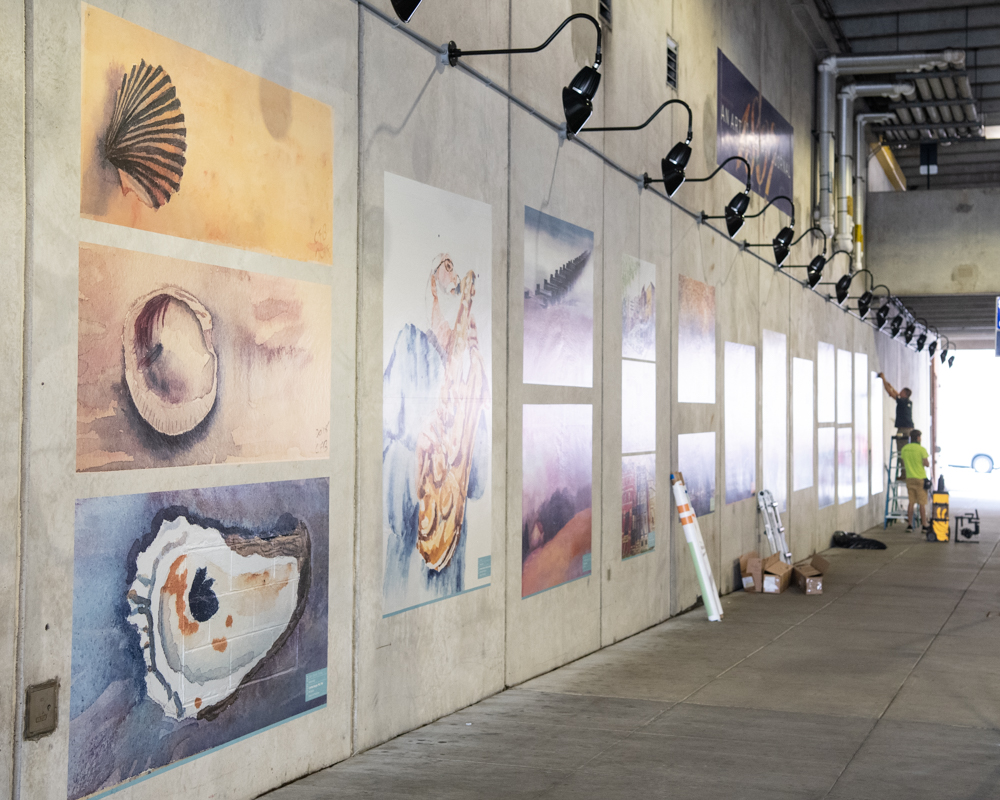The Pearl Street underpass on the University of Maryland, Baltimore (UMB) campus is getting some added luster: an exhibit of artwork that was featured in the inaugural issue of 1807: An Art & Literary Journal.

The Pearl Street underpass has been transformed into an exhibit featuring 32 pieces of art from the inaugural 1807 journal.
A turtle swimming in the sea, three iconic Baltimore scenes, an angler fish made of metal, and a poem about living with mental illness are just some of the 32 pieces of art exhibited as part of the University project.
The exhibit, known as the UMB Pearl Gallery, was inspired by the spring 2019 issue of 1807, which encourages students, faculty, staff, and community members to submit unpublished artwork in the categories of visual arts (painting, drawing, illustration, digital art), photography, varied media (sculpture, clay, metal, glass, textiles, jewelry, wood), and the written word (short story, essay, narrative, poetry).
UMB Interim President Bruce E. Jarrell, MD, FACS, who is an artist himself, said of the gallery, “I am in awe of the creative talent that is evident in our University community, our alumni community, and the greater UMB community. While our community and world face daunting challenges during the pandemic, it is gratifying to celebrate art at UMB in such a public way.”
The work of 28 artists that appeared in the 60-plus-page journal is featured on the wall, and each discipline is represented.
“We looked to select art from each category, even the writing, so that each category could be represented in the collection,” said co-project manager Dana Rampolla, assistant director of marketing, alumni communications and special projects for the University. “We took into consideration balancing color, composition, file size, and type of artwork along the wall so that the individual concrete panels where the art is hung would complement one another.”
The exhibit, which has been completed and will be displayed indefinitely, includes photography, paintings, photographs of three-dimensional pieces, and poetry placed on vinyl appliques by AP Graphics of Sykesville.
First, LED spotlights controlled by photocell were installed by Maranto Electrical Construction above where each piece of art would be placed, and the wall was power washed. Then AP Graphics used a handheld torch to apply heat to the vinyl, according to Rampolla. Workers used a roller to give it “a relatively seamless finish at the end,” she said. “It’s like it almost added an element of texture, which is kind of a cool outcome that we weren’t expecting.”
Jennifer Litchman, MA, senior vice president for external relations, special assistant to the president, and founding chair of the UMB Council for the Arts & Culture, which was the driving force behind 1807, said, “The Pearl Gallery is the extension of a dream the council had for an arts journal when the council was initially founded. Making the art so publicly available speaks volumes to the importance the University community places on art as an essential complement to science and healing.
“I am so looking forward to the day that we are all back on campus so that everyone can take a walk or drive by the gallery and find some peace, beauty, and solace in such uncertain times,” added Litchman, who is the 1807 editor-in-chief.
Noly Empeno, project manager, design and construction, who oversaw construction and funding for the exhibit, said the underpass was the perfect spot for a project like this. “It is a bit darker and the graphics become highlights,” he said, adding that the exhibit is “very informative.”
Rampolla, who worked with University architect Anthony Consoli, AIA, LEED AP, on the design of the wall, recently went to campus to see the project being installed. The exhibit is adjacent to the Pearl Street Garage on the north side of campus between Fayette and Lexington streets.
“Suddenly the underpass was filled with color and words that passers-by stopped to gaze at,” said Rampolla, who also serves as the journal’s creative director/managing editor. “We have some truly fabulous artists in the UMB community — it’s incredibly rewarding to be able to provide not just one, but several opportunities to share their talent.”
In addition to UMB Pearl Gallery, the 1807 artists’ work was on display last year in an exhibit at the Health Sciences and Human Services Library’s Weise Gallery.
Victoria Braudaway, a University of Maryland School of Nursing student, said she was speechless when she found out her painting “Honu” would be featured in the Pearl Gallery.
“Painting has always been a wonderful outlet for me, and to be recognized for something that is so personal to me was eye opening on the limitless potential we all have,” she said.
Owen White, PhD, director of bioinformatics, University of Maryland School of Medicine, and associate director, Institute for Genome Sciences, works with stainless steel, wood, custom animatronics, and found objects. His varied media work “Angler Fish” is featured in the Pearl Gallery.
He said he hopes that the art will be “a conversation starter for people to examine the intersection between technology, art, and nature.”
The four types of media are color-tagged on the wall, just as they are in the journal, to add continuity to the design of the exhibit. Each piece has a bottom border with the corresponding color, and the artist’s name is displayed with the same background color. There’s a color key on the wall that matches the journal.
The University plans an HGTV-style, socially distanced reveal of the exhibit in August and a Virtual Face to Face with Dr. Bruce Jarrell edition on the project in September.
“The gallery shows that we are making an effort through our beautification efforts to make the campus attractive,” Rampolla said. “The underpass was really dark and dingy. Now, however, it is filled with beautiful art that broadly and creatively relates to the council’s themes of social justice, health, healing, the mind, and the body, created by our UMB community of artists.”


